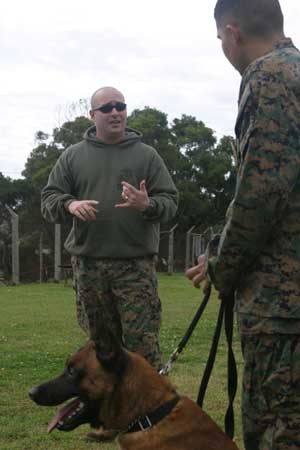Marine Headline News
K-9s
give 42 reasons why crime doesn’t pay
by Sgt Matt Scotten, Distribution Specialist
Okinawa Marine Newspaper
KADENA AIR BASE, OKINAWA, Japan -- He patrols
the streets of U.S. military installations on Okinawa
throughout the night; guarding, protecting, serving. He
and his partner’s only mission is to safeguard residents
from an unknown enemy, whomever it may be. This defender
is the military working dog.
For the Marines and dogs at the military
working dog section of the Marine Corps Base Camp Butler
Provost Marshal’s Office, their mission is simple; to serve
and protect.
The 21 military working dogs and their
handlers assist military police units here with protecting
servicemembers and military installations islandwide,
explained Sgt. Kip L. Hogan, training chief for the military
working dog section.
“Two teams, each consisting of a dog and
handler, are on duty 24 hours a day,” Hogan said. “Each
night we patrol a different camp on the island. We respond to
calls just like a regular road unit, in addition to any
incident which might need K-9-specific attention.”
There are two functional areas for working
dogs, drug work and bomb work. The handlers have important
responsibilities within the Marine Corps with regards to the
war on terrorism and the safety of servicemembers on Okinawa,
Hogan explained.
Most dogs are of the Belgian Malinois breed,
which is selected by the military services because of the
dogs’ intelligence, intensity and long life span, Hogan
added. Each dog is basically trained for his specialty at the
U.S. Army Military Working Dog School at Lackland Air Force
Base, San Antonio.
Upon completion of the 120-day training
course, the dogs are brought to Okinawa and assigned to a
handler, explained Lance Cpl. Chris Diaz, a handler with the
military working dog section. This is when the dogs’ real
training begins.
“With a dog, there are lots of psychological
issues,” Diaz said. “They are like people. It’s a
relationship that takes trust, teamwork and respect, which all
have to be earned. Dogs aren’t like an (M-16 A2 service
rifle). They aren’t mechanical.”
Once drug dogs “hit the road” here, they
can support the U.S. Customs Service at Kadena Air Base,
Marine Corps Air Station Futenma or the Naha port facility,
Hogan explained. The dogs are trained to find many types of
drugs, paraphernalia and explosives. The dogs are also trained
in routine, police-type work, which gives them the capability
to work normal highway patrols.
Bomb dogs are used to search automobiles,
luggage and special areas and are certified to detect
explosives at or above a 95 percent accuracy rate, explained
Cpl. Terry R. Donaldson, a dog handler with the section. Many
times dogs are used to work at spot checks at the entrances of
military installations.
Donaldson spent time with his dog while on
deployment in Djibouti, Africa, and stressed the importance of
having a bomb dog at the gates of military installations.
The military working dogs also help keep the
bases on Okinawa safe by providing a psychological and
physical deterrent to terrorists, Hogan explained.

KADENA AIR BASE, OKINAWA, Japan — Cpl.
Quyen Q. Au receives a bite from Waldo during aggression
training here March 3. Military working dog teams, consisting
of one dog and one handler, train together every day to build
a strong working relationship. Au is a military working dog
handler with the military working dog section, Marine Corps
Base Camp Butler Provost Marshal’s Office. (Official U.S.
Marine Corps photo by Lance Cpl. Martin R. Harris)(released)

KADENA AIR BASE, OKINAWA, Japan — Sgt.
Kip L. Hogan gives Lance Cpl. Chris Diaz a period of military
instruction about handling his partner, Lex, here March 3. The
military working dogs are assigned to individual trainers to
assist the military police units in keeping military
installations islandwide safe. Hogan is the training chief,
and Diaz is a military working dog handler with the military
working dog section, Marine Corps Base Camp Butler Provost
Marshal’s Office. (Official U.S. Marine Corps photo by Lance
Cpl. Martin R. Harris)(released)